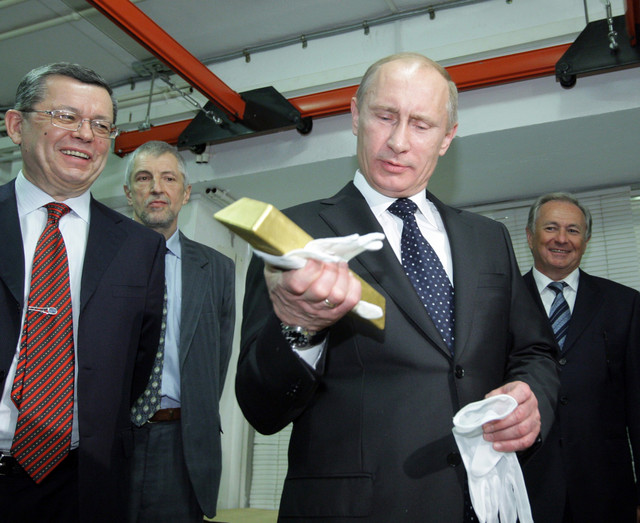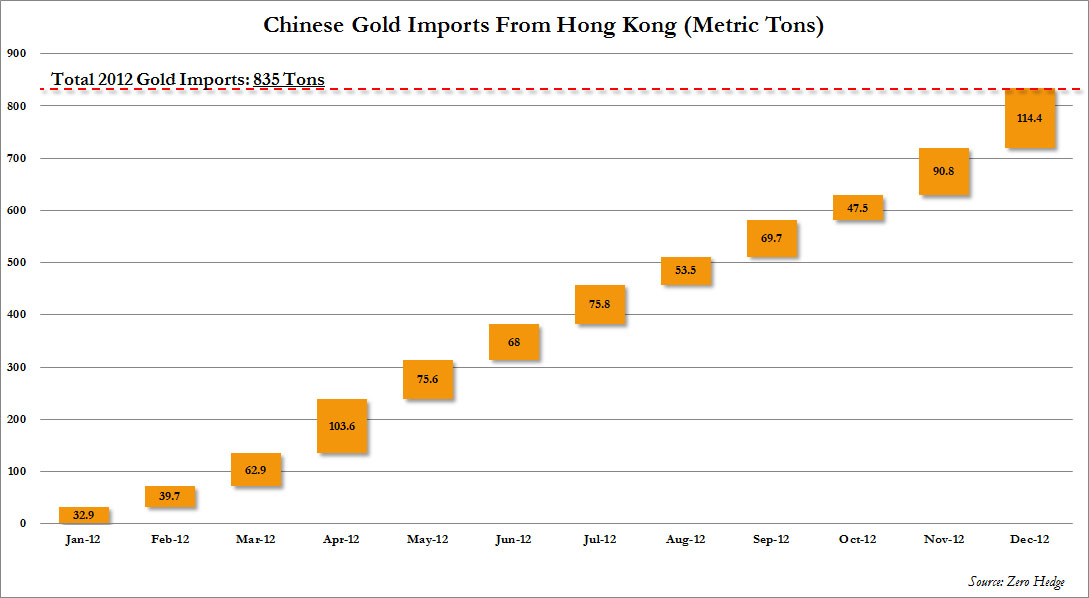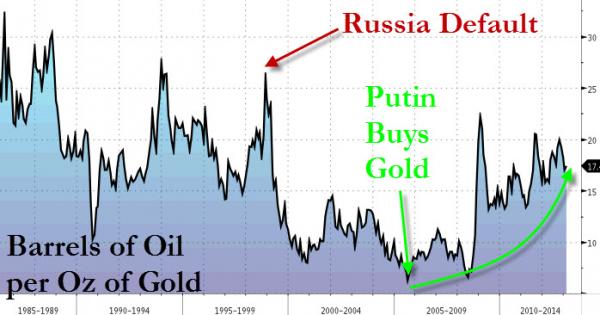– Russia Flips Petrodollar On Its Head By Exporting Crude, Buying Record Gold (ZeroHedge, Feb 10, 2013):
China has been a very active purchaser of gold for its reserves in the last few years, as we extensively covered here and here, but another nation has taken over the ‘biggest buyer’ role (for the same reasons as China).
Central banks around the world have printed money to escape the global financial crisis, and as Bloomberg reports, IMF data shows Russia added 570 metric tons in the past decade. Putin’s fears that “the U.S. is endangering the global economy by abusing its dollar monopoly,” are clearly being taken seriously as the world’s largest oil producer turns black gold into hard assets. A lawmaker in Putin’s party noted, “the more gold a country has, the more sovereignty it will have if there’s a cataclysm with the dollar, the euro, the pound or any other reserve currency.”
Putin’s gold strategy fits in with his resource nationalism, statist agenda, as Bloomberg notes when Russia defaulted in 1998 it took 28 barrels of oil to buy one ounce of gold, was 11.5 barrels when Putin came to power and when in 2005 it had fallen to 6.5 barrels (less than half what it is now), he went all in, telling the central bank to buy.
Russia has gone through bouts of hoarding before – from 1867’s Tsar Alexander II to Lenin, for now, with more than five years left in Putin’s term, Russia plans to keep on buying – “The pace will be determined by the market,” First Deputy Chairman Alexei Ulyukayev said in an interview in Davos, Switzerland, on Jan. 25. “Whether to speed that up or slow it down is a market decision and I’m not going to discuss it.”
Putin Turns Black Gold Into Bullion as Russia Out-Buys World
When Vladimir Putin says the U.S. is endangering the global economy by abusing its dollar monopoly, he’s not just talking. He’s betting on it.
Not only has Putin made Russia the world’s largest oil producer, he’s also made it the biggest gold buyer. His central bank has added 570 metric tons of the metal in the past decade, a quarter more than runner-up China, according to IMF data compiled by Bloomberg. The added gold is also almost triple the weight of the Statue of Liberty.
“The more gold a country has, the more sovereignty it will have if there’s a cataclysm with the dollar, the euro, the pound or any other reserve currency,” Evgeny Fedorov, a lawmaker for Putin’s United Russia party in the lower house of parliament, said in a telephone interview in Moscow.
…
In 1998, the year Russia defaulted on $40 billion of domestic debt, it took as many as 28 barrels of crude to buy an ounce of gold, Bloomberg data show. That ratio tumbled to 11.5 by the time Putin first came to power a year later and in 2005, after it touched 6.5 — less than half what it is now — the president told the central bank to buy.
During a tour that November of the Magadan region in the Far East, where Polyus Gold International Ltd. and Polymetal International Plc have operations, Putin told Bank Rossii not to “shy away” from the metal. “After all, they’re called gold and currency reserves for a reason,” Putin said, according to a Kremlin transcript.
Lucky Guy
At the time, gold was trading at an 18-year high of $495 an ounce and the Moscow-based central bank held 387 tons, or 2.2 percent of its $165 billion total reserves. The share reached 3.5 percent within a month, according to data compiled by Bloomberg.
An ounce of gold for immediate delivery traded at $1,670 as of 7:24 p.m. Moscow time on Feb. 8. It rose 7 percent last year, the 12th straight year of gains. Analysts expect the metal to advance again in 2013, to $1,825 by the end of the year, according to the median of 26 forecasts in a Bloomberg survey.
“Putin’s gold strategy fits in with his resource nationalism, statist agenda,” said Tim Ash, head of emerging- market research at Standard Bank Plc in London. “It’s kind of a defensive play, but it worked, right?” Ash said in an interview in Moscow. “You need luck in politics and business, and clearly the guy has it.”
Brown’s Bottom
Other world leaders haven’t been as lucky. Gordon Brown, as U.K. finance minister, sold almost 400 tons of gold in the 30 months to March 2002, when prices were at two-decade lows. London tabloids have referred to the period as Brown’s Bottom.
Quantitative easing by major economies to support financial asset prices is driving demand for gold in the emerging world, said Marcus Grubb, head of investment research at the World Gold Council. Before the crisis, central banks were net sellers of 400 to 500 tons a year. Now, led by Russia and China, they’re net buyers by about 450 tons,
…
While Putin is leading the gold rush in emerging markets, developed nations are liquidating. Switzerland unloaded the most in the past decade, 877 tons, an amount now worth about $48 billion, according to International Monetary Fund data through November. France was second with 589 tons, while Spain, the Netherlands and Portugal each sold more than 200 tons.
No Hoard
Communist secrecy regarding the country’s gold holdings fueled speculation that party elites had amassed a huge hoard of bullion that they spirited out of the country before the Soviet Union disintegrated in 1991.
…
“When people ask about the party’s gold, my answer is always: Are you an idiot or something?” Gerashchenko, 75, told Afisha magazine.
For now, with more than five years left in Putin’s term, Russia plans to keep on buying.
“The pace will be determined by the market,” First Deputy Chairman Alexei Ulyukayev said in an interview in Davos, Switzerland, on Jan. 25. “Whether to speed that up or slow it down is a market decision and I’m not going to discuss it.”


